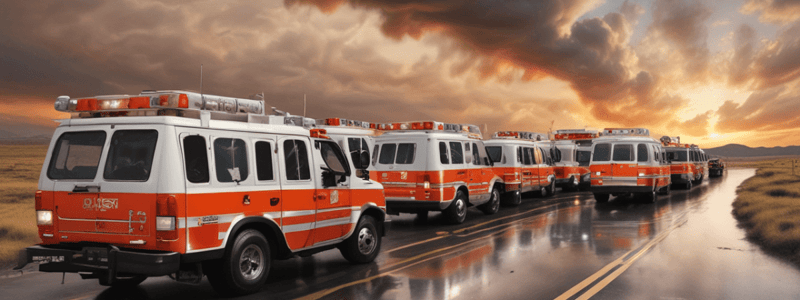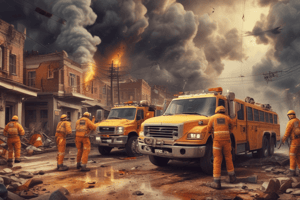Podcast
Questions and Answers
What is the primary distinction between a disaster and a multiple casualty incident?
What is the primary distinction between a disaster and a multiple casualty incident?
- The availability of resources (correct)
- The number of patients involved
- The severity of the injuries
- The location of the incident
What is the primary goal of the National Incident Management System (NIMS)?
What is the primary goal of the National Incident Management System (NIMS)?
- To promote efficient coordination of emergency incidents at the local level
- To prepare for, prevent, respond to, and recover from domestic incidents (correct)
- To enhance responder safety and communication
- To provide a systematic approach to incident management
What is the primary purpose of the Incident Command System (ICS)?
What is the primary purpose of the Incident Command System (ICS)?
- To provide a consistent nationwide approach to incident management
- To promote efficient coordination of emergency incidents at the local level
- To enhance responder safety and communication
- To manage incidents with a large number of patients (correct)
What are the two major underlying principles of the National Incident Management System (NIMS)?
What are the two major underlying principles of the National Incident Management System (NIMS)?
What are the major components of the National Incident Management System (NIMS)?
What are the major components of the National Incident Management System (NIMS)?
What is the primary purpose of an Incident Command System (ICS)?
What is the primary purpose of an Incident Command System (ICS)?
What is the primary purpose of the START triage method?
What is the primary purpose of the START triage method?
What is the age and weight criteria for using the JumpSTART pediatric triage system?
What is the age and weight criteria for using the JumpSTART pediatric triage system?
In what type of incidents must patients be decontaminated before triage takes place?
In what type of incidents must patients be decontaminated before triage takes place?
How are patients transported in a disaster response scenario?
How are patients transported in a disaster response scenario?
What is the purpose of early notification to receiving facilities in a disaster response?
What is the purpose of early notification to receiving facilities in a disaster response?
Who is responsible for overall incident management?
Who is responsible for overall incident management?
What is the primary purpose of the finance and administration section?
What is the primary purpose of the finance and administration section?
What is the role of the logistics department?
What is the role of the logistics department?
What is the primary function of the operations section?
What is the primary function of the operations section?
Who is responsible for monitoring the scene for hazards?
Who is responsible for monitoring the scene for hazards?
What is the primary purpose of incident demobilization?
What is the primary purpose of incident demobilization?
What is the role of the medical branch in ICS?
What is the role of the medical branch in ICS?
Who is responsible for counting and prioritizing patients?
Who is responsible for counting and prioritizing patients?
What is the purpose of triage in MCI?
What is the purpose of triage in MCI?
What is the purpose of triage tags or tapes?
What is the purpose of triage tags or tapes?
Flashcards are hidden until you start studying
Study Notes
- Incident Management deals with the most challenging situations, such as disasters and mass casualty incidents, which overwhelm available resources.
- A disaster is any situation that overwhelms resources, while a multiple casualty incident refers to a situation with more than one patient, but without overwhelming resources.
- The Incident Command System (ICS) is used to manage incidents with a large number of patients, providing a systematic approach to incident management.
- The National Incident Management System (NIMS) was developed in 2004 to promote efficient coordination of emergency incidents at the regional, state, and national levels.
- NIMS provides a consistent nationwide approach to incident management, preparing for, preventing, responding to, and recovering from domestic incidents regardless of cause, size, or complexity.
- The two major underlying principles of NIMS are flexibility and standardization, which provide standardization in terminology, resource classification, personnel training, and certification.
- The major components of NIMS include fundamentals and concepts, resource management, command and coordination, and communications and information management.
- The purpose of an incident command system is to enhance command control and communication abilities, ensuring responder and public safety, achieving incident management goals, and using resources efficiently.
- The Incident Commander is responsible for the overall incident, assessing the incident, establishing strategic objectives and priorities, and developing the plan.
- A unified command system is necessary for efficient response to large incidents, with a single Incident Commander in charge, even if multiple agencies respond.
- Communication is crucial in incident management, and a transfer of command should be communicated to all parties involved.
- The finance and administration section is responsible for documenting all expenditures related to the incident.
- The logistics department is responsible for providing communication equipment, facilities, food, water, fuel, lighting, and medical equipment supplies for patients and emergency responders.
- Operations are responsible for supervising people working at the scene, while planning solves problems as they arise, selecting strategies to meet objectives, and determining the resources needed to execute the plan.
- The Command Staff includes safety officers, public information officers, and liaison officers, who monitor the scene for hazards and provide information to the public and media.
- Communications are critical in incident management, and all agencies should be able to communicate quickly and effortlessly via radios.
- Incident demobilization allows for the prompt return of resources to their parent organizations, and recordkeeping is essential for tracking time spent on the incident and for reimbursement purposes.
- In an incident command system, EMS response comes down to preparedness, scene size-up, and asking the right questions, such as what resources are needed, what needs to be done, and what tools are required.
- The medical branch of ICS includes triage, treatment, and transport of injured people, with the medical branch director supervising primary roles.
- The triage supervisor is responsible for counting and prioritizing patients, ensuring each patient receives an initial assessment of their condition.
- The treatment supervisor sets up the treatment area with a tier for each priority of patient, performing secondary triage and providing adequate patient care.
- The transportation supervisor coordinates transportation and distribution of patients to appropriate receiving hospitals, documenting and tracking the number of transport vehicles, patients transported, and facility destinations.
- The staging supervisor assigns permissions to emergency vehicles to enter and drive in directed areas, locates an area to stage equipment and responders, and tracks unit arrivals and releases vehicles and supplies.
- The rehabilitation supervisor establishes an area to provide for responders from the elements and situation, monitoring responders for signs of physical and emotional stress.
- The extrication supervisor determines the type of equipment and resources needed for rescue operations, usually functioning under the medical branch of the IC.
- The morg supervisor coordinates the removal of bodies and body parts, ensuring a secure and private area for the process.
- An MCI is declared when a call could overwhelm available community resources or requires a mutual aid response, and protocols for declaring an MCI vary among EMS systems.
- Triage is based on the severity of injuries, with a brief assessment and categorization of patients using a unique number and triage category.
- The primary triage is done in the field, while secondary triage is done in the treatment area, with the triage supervisor communicating information to the medical branch director.
- There are four common triage categories: immediate (red), delayed (yellow), minimal (green), and expectant (black), with patients receiving treatment and transport according to their priority.
- Triage tags or tapes are used to track patients, with color-coded categories and accurate records of patient condition.
- The START triage method is a simple and effective way to assess patients, using a limited assessment of patient ability to walk, respiratory status, hemodynamic status, and neurologic status.
- JumpSTART is a pediatric triage system, adapted for children younger than 8 years or weighing less than 100 pounds.
- In Hazmat and weapons of mass destruction incidents, patients must be identified as contaminated or decontaminated before the regular triage process.
- Patients are transported according to their priority, with immediate priority patients transported first, followed by delayed category patients, and finally the walking wounded.
- Early notification to receiving facilities allows for increased staffing and preparation for incoming patients.
- In disasters, responders may be on scene for days to weeks or even months, and area hospitals may mobilize medical teams to set up casualty collection areas for triage, medical care, and transport of patients.
Studying That Suits You
Use AI to generate personalized quizzes and flashcards to suit your learning preferences.



